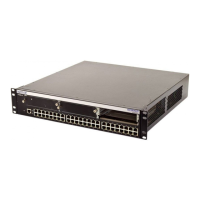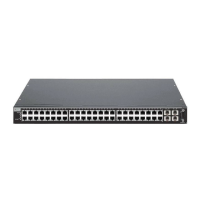Link Aggregation Control Protocol (LACP)
11-44 Port Configuration
Link Aggregation Control Protocol (LACP)
Using multiple links simultaneously to increase bandwidth is a desirable switch feature, which
can be accomplished if both sides agree on a set of ports that are being used as a Link Aggregation
Group (LAG). Once a LAG is formed from selected ports, problems with looping can be avoided
since the Spanning Tree can treat this LAG as a single port.
The Link Aggregation Control Protocol (LACP) logically groups interfaces together to create a
greater bandwidth uplink, or link aggregation, according to the IEEE 802.3ad standard. This
standard allows the switch to determine which ports are in LAGs and configure them
dynamically. Since the protocol is based on the IEEE 802.3ad specification, any switch from any
vendor that supports this standard can aggregate links automatically.
802.3ad LACP aggregations can also be run to end-users (that is, a server) or to a router.
For more information about configuring LACP, see the “Configuring Link Aggregation” Feature
Guide on the Enterasys web site: https://extranet.enterasys.com/downloads/
LACP Operation
For each aggregatable port in the device, LACP:
• Maintains configuration information (reflecting the inherent properties of the individual links
as well as those established by management) to control aggregation.
• Exchanges configuration information with other devices to allocate the link to a Link
Aggregation Group (LAG).
• Attaches the port to the aggregator used by the LAG, and detaches the port from the
aggregator when it is no longer used by the LAG.
• Uses information from the partner device’s link aggregation control entity to decide whether
to aggregate ports.
The operation of LACP involves the following activities:
• Checking that candidate links can actually be aggregated.
• Controlling the addition of a link to a LAG, and the creation of the group if necessary.
• Monitoring the status of aggregated links to ensure that the aggregation is still valid.
• Removing a link from a LAG if its membership is no longer valid, and removing the group if it
no longer has any member links.
In order to allow LACP to determine whether a set of links connect to the same device, and to
determine whether those links are compatible from the point of view of aggregation, it is
necessary to be able to establish:
Caution: Link aggregation configuration should only be performed by personnel who are
knowledgeable about Spanning Tree and Link Aggregation, and fully understand the ramifications
of modifications beyond device defaults. Otherwise, the proper operation of the network could be
at risk.
Note: Earlier (proprietary) implementations of port aggregation referred to groups of aggregated
ports as “trunks”.
Note: A given link is allocated to, at most, one Link Aggregation Group (LAG) at a time. The
allocation mechanism attempts to maximize aggregation, subject to management controls.

